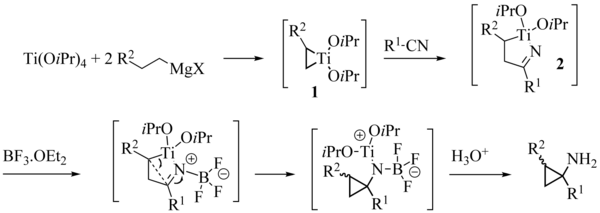Kulinkovich reaction
| Kulinkovich reaction | |
|---|---|
| Named after | Oleg Kulinkovich |
| Reaction type | Ring forming reaction |
| Identifiers | |
| Organic Chemistry Portal | kulinkovich-reaction |
| RSC ontology ID | RXNO:0000682 |
The Kulinkovich reaction describes the organic synthesis of substituted cyclopropanols through reaction of esters with dialkyldialkoxytitanium reagents, which are generated in situ from Grignard reagents containing a hydrogen in beta-position and titanium(IV) alkoxides such as titanium isopropoxide.[1] This reaction was first reported by Oleg Kulinkovich and coworkers in 1989.[2]

Titanium catalysts are ClTi(OiPr)3 or Ti(OiPr)4, ClTi(OtBu)3 or Ti(OtBu)4, Grignard reagents are EtMgX, PrMgX or BuMgX. Solvents can be Et2O, THF, toluene. Tolerated
An
Reaction mechanism
The generally accepted
The step leading to the titanacyclopropane has been scrutinized computationally. Although the dialkyldiisopropoxytitanium complex has been proposed to undergo β hydrogen elimination followed by C–H reductive elimination to give the alkane and 1, it was found that β hydrogen abstraction by the alkyl group, leading directly to products without the intermediate titanium hydride, is a more favorable process.[3]
In broad strokes, and in a formal retrosynthetic sense, titanacyclopropane 1 behaves like a 1,2-dianion which adds into the ester twice: after the first addition into the ester, the resultant tetrahedral intermediate 2 collapses to give β-titanio ketone 3, which undergoes a second intramolecular addition to give the titanium salt of the cyclopropanol (4). (This species then undergoes transmetalation with Grignard reagent to regenerate 1 and close the catalytic cycle and give the product in the form of the magnesium salt (5).)
The reaction mechanism has been the subject of theoretical analysis.[4] Certain points remain nevertheless obscure. Intermediate titanium complexes of the ate type have been proposed by Kulinkovich.[5]
Ligand exchange with olefins
In 1993, the team of Kulinkovich highlighted the aptitude of the titanacyclopropanes to undergo
The methodology has been extended to intramolecular reactions[8]
De Meijere variation
| Kulinkovich–De Meijere reaction | |
|---|---|
| Named after | Oleg Kulinkovich Armin de Meijere |
| Reaction type | Ring forming reaction |
| Identifiers | |
| Organic Chemistry Portal | kulinkovich-demeijere-reaction |
| RSC ontology ID | RXNO:0000683 |
With
The intramolecular reaction is also known:[11][12][13][14][15][16][17][18][19][20]
Szymoniak variation
| Kulinkovich–Szymoniak reaction | |
|---|---|
| Named after | Oleg Kulinkovich Jan Szymoniak |
| Reaction type | Ring forming reaction |
| Identifiers | |
| Organic Chemistry Portal | kulinkovich-szymoniak-reaction |
| RSC ontology ID | RXNO:0000684 |
In the Szymoniak variation the substrate is a nitrile and the reaction product a cyclopropane with a primary amine group.[21][22]
The reaction mechanism is akin the Kulinkovich reaction:
Additional reading
- Kulinkovich, O. G.; Sviridov, S. V.; Vasilevski, D. A. (1991). "Titanium(IV) Isopropoxide-Catalyzed Formation of 1-Substituted Cyclopropanols in the Reaction of Ethylmagnesium Bromide with Methyl Alkanecarboxylates". Synthesis. 1991 (3): 234. .
- Kulinkovich, O. G.; De Meijere, A. (2000). "1,n-Dicarbanionic Titanium Intermediates from Monocarbanionic Organometallics and Their Application in Organic Synthesis". Chem. Rev. 100 (8): 2789–834. PMID 11749306.
- Sato, F.; Urabe, H.; Okamoto, S. (2000). "Synthesis of organotitanium complexes from alkenes and alkynes and their synthetic applications". Chem. Rev. 100 (8): 2835–86. PMID 11749307.
- Wu, Y.-D.; Yu, Z.-X. (2001). "A theoretical study on the mechanism and diastereoselectivity of the Kulinkovich hydroxycyclopropanation reaction". J. Am. Chem. Soc. 123 (24): 5777–86. PMID 11403612.
- Kulinkovich, O. G. (2004). "Alkylation of carboxylic acid derivatives with dialkoxytitanacyclopropane reagents". Russ. Chem. Bull. 53 (5): 1065–1086. S2CID 98642553.
- Wolan, A.; Six, Y. (2010). "Synthetic transformations mediated by the combination of titanium(IV) alkoxides and grignard reagents: Selectivity issues and recent applications. Part 1: Reactions of carbonyl derivatives and nitriles". Tetrahedron. 66: 15–61. .
- Wolan, A.; Six, Y. (2010). "Synthetic transformations mediated by the combination of titanium(IV) alkoxides and Grignard reagents: Selectivity issues and recent applications. Part 2: Reactions of alkenes, allenes and alkynes". Tetrahedron. 66 (17): 3097–3133. .
- Corey, E. J.; Rao, S. A.; Noe, M. C. (1994). "Catalytic Diastereoselective Synthesis of Cis-1,2-Disubstituted Cyclopropanols from Esters Using a Vicinal Dicarbanion Equivalent". Journal of the American Chemical Society. 116 (20): 9345. .
References
- ^ ISBN 978-0471264187.
- ^ Kulinkovich, O. G.; Sviridov, S. V.; Vasilevskii, D. A.; Pritytskaya, T. S. (1989). "Reaction of ethylmagnesium bromide with carboxylic acid esters in the presence of tetraisopropoxytitanium". Zh. Org. Khim. 25: 2244.
- ISSN 0276-7333.
- PMID 11403612.)
{{cite journal}}: CS1 maint: multiple names: authors list (link - .
- .
- .
- .
- .
- ^ De Meijere, A.; Winsel, H. and Stecker, B. Organic Syntheses, Vol. 81, p. 14 Archived 18 September 2012 at the Wayback Machine
- .
- .
- PMID 10814442.
- PMID 11697988.
- .
- PMID 12583749.
- PMID 14518121.
- PMID 14767944.
- .
- .
- PMID 12240317.
- .






